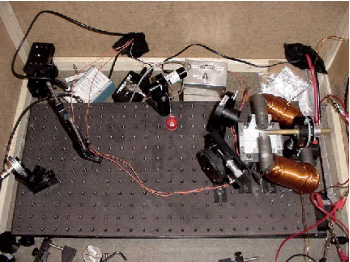MOKE
We use a technique called MOKE (Magneto Optic Kerr Effect), to analyze and characterize some films. The basic principle behind MOKE is that as polarized light interacts with a magnetic material the polarization of the light can change. Just think of the light coupling to the electrons in the material. If something changes with the electrons, some of their spin perhaps, then the light's polarization can change as well. In fact the strength of the magnetization of the material affects the change in the polarization of the light.
For our lab we have a typical MOKE setup. We have a laser, two polarizers, a magnet, and a light detector. The light goes through the first polarizer and strikes the sample, which is in the magnet. The light then reflects off the sample through the other polarizer and into the detector. Now the key thing here is that if the polarization of the light changed when it was reflected off the sample, because it is magnetized, then the intensity of the light must change. By seeing how the intensity of the light changes, as the magnetic field that passes through the sample changes, we can measure how the magnetization of the sample changes with applied field. For a Ferro-magnet we would see a hysteresis curve. We can use this information to characterize a sample and find out how the magnetization along different axes change with applied fields.

Our home-built MOKE system
